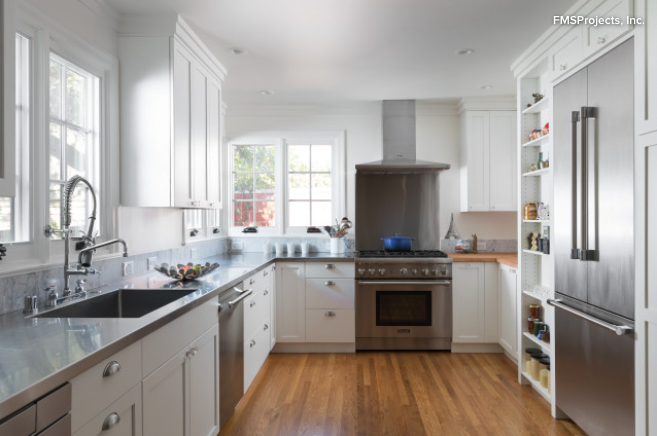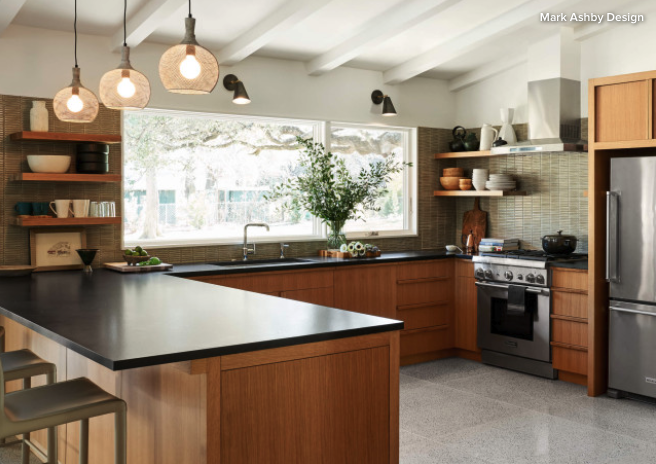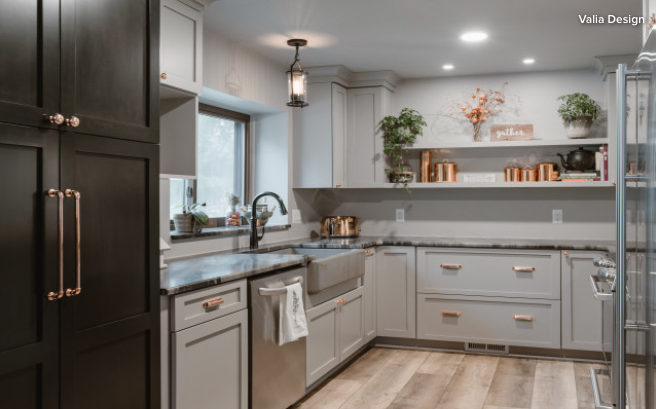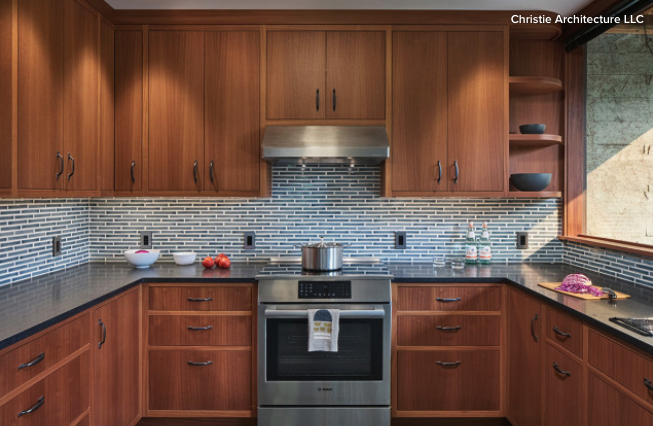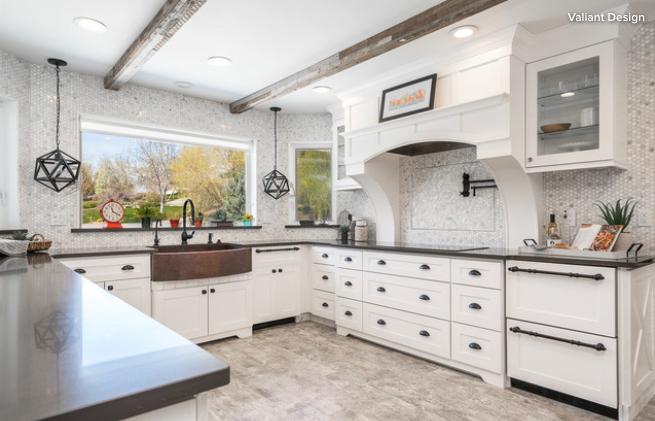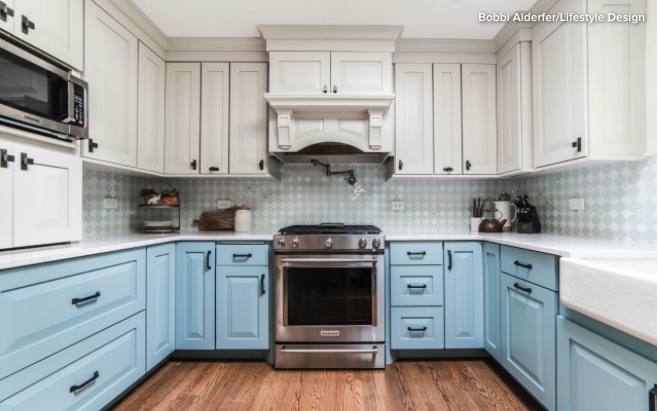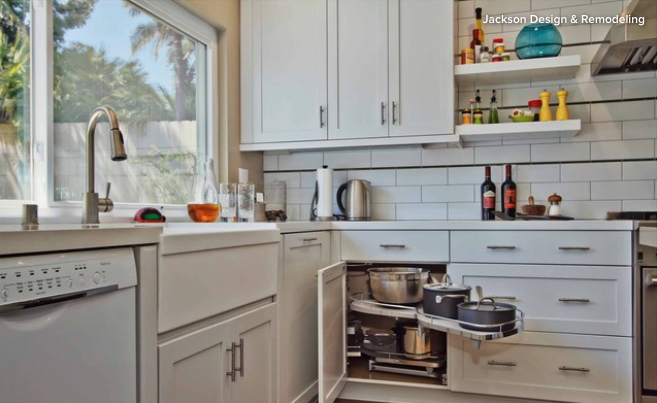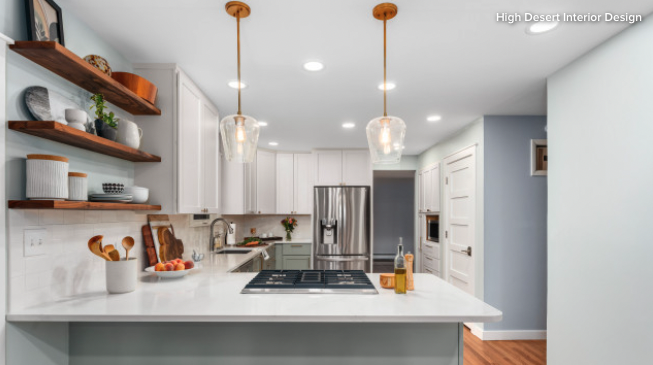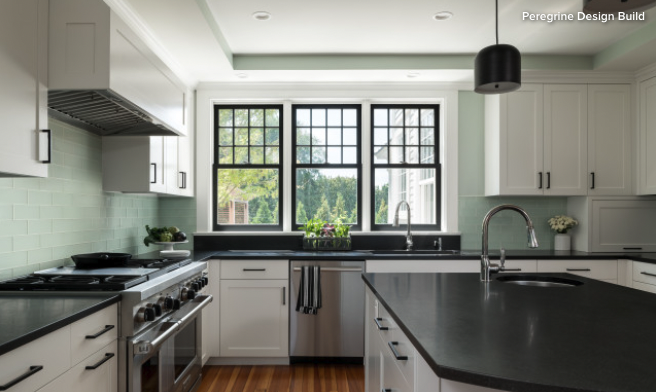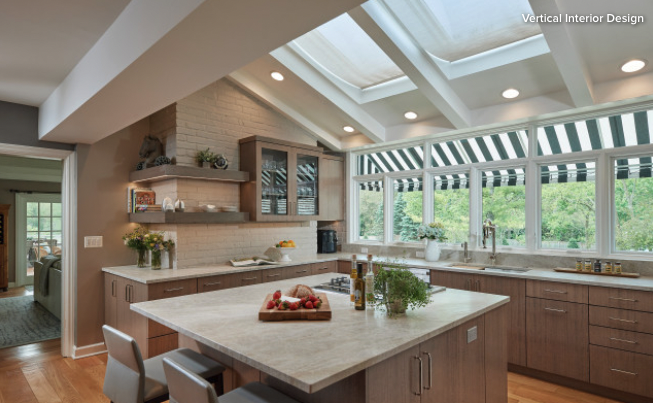A U-shaped kitchen, sometimes called a C-shaped kitchen, has work space on three adjoining walls of cabinetry, with an open end for access. In a small U-shaped kitchen, the opposing cabinet runs effectively become a galley layout, but with one end closed off. This galley format works for larger kitchens too, although if the opposing runs are too far apart, this can reduce the kitchen’s efficiency. Is a U-shaped layout the right choice for your kitchen — and, if so, how can you best make the most of it?
Know the Pros and Cons of the U-Shaped Design
Generally, U-shaped kitchens provide lots of storage and work surface. They’re also very safe since they have only one entrance and no traffic. This last point, however, also means that within small U-shaped layouts, there may be space for only one cook at a time. It’s also worth noting that U-shaped layouts are typically more expensive than others, such as galley or L-shaped designs, because they require more cabinetry and countertop material for the additional run of cabinets.
Plan Your Layout
The cabinetry lengths on a U-shaped kitchen can be roughly the same or vary; in both cases, there’s an opportunity for flexibility within the design. Where all walls are the same length (for example, 10 feet), your starting point for planning usually depends on where the windows are located.
If one of the walls has a window, this usually would be the run we’d suggest for your kitchen sink. Not only will a window offer natural light for washing up, but there’s also the romantic notion of gazing outward while doing the dishes. This, of course, very much depends on your view.
Position the Sink and Cooktop
If the sink sits in the middle run of a U-shaped layout, then your stove can be located on either of the other runs. However, if these two runs vary in length, the longer wall would usually house the range to allow more space on either side of it.
Meanwhile, if the sink is on a run other than the middle one, as pictured here, we would try to ensure a continuous flow of countertop from this point onward, and around the U. So if you were including tall cabinets, this would mean locating them together at the farthest end of the cabinetry run (as in this kitchen). This deliberate spacing ensures that the counter isn’t interrupted and the kitchen’s functionality (in the form of a galley layout) is unhampered.
Employ Symmetry
U-shaped kitchens offer the opportunity for symmetry within a design, as long as it doesn’t compromise the kitchen’s usability. While it’s not essential, many homeowners appreciate symmetry for the resulting clean and balanced aesthetic.
We would usually choose an appliance, such as an oven or oversize range hood, for the midpoint of the central run, as pictured here. We’d then work outward, implementing furniture and appliances accordingly.
Of course, you can deviate from a symmetrical layout, either because you think it will look better in your space or because the room’s structure dictates it — for example if a doorway or window interrupts one of the runs.
Hide Less-Than-Lovely Features
U-shaped kitchens can also be designed so they mask less attractive kitchen components and appliances behind cabinetry. Through foresight in planning, they can be obscured from sight. This is particularly beneficial in an open-plan kitchen. In this kitchen, the appliances are hidden behind cabinet fronts.
Maximize an Efficient Work Space
Whatever the size, a well-planned U-shaped kitchen design will ensure that only a limited number of steps are needed between cabinets and appliances. This makes the kitchen a much safer place for cooking, especially when other people are present.
In addition, having generous counter space and storage means everything’s within reach and easily tidied after use to maintain a clean and uncluttered look.
Incorporate Corner Storage
As mentioned, one of the great advantages of a U-shaped kitchen is that having three runs of cabinetry provides ample opportunity for storage. Having said that, the two corners in a typical U-shaped kitchen take up significant floor space.
So to achieve an ergonomically sound design, it’s important to select a specialist kitchen corner solution, such as a carousel or LeMans corner unit (seen here, and so-called because its shape and curves are reminiscent of the famous French racetrack). These make use of the otherwise dead space within corner cabinets. Without these options, you’d lose this space or the back of your cabinets would be extremely difficult to access.
Add a Peninsula
Small U-shaped kitchens can be restricting, particularly if there’s no space for a table and chairs. But sometimes it’s possible to arrange the U shape so that one of the legs extends into open space (even if this means restructuring to take down a wall).
While you would lose the upper cabinets, the lower cabinets could then form a highly efficient kitchen peninsula. You could add stools to make the space more sociable, and it would offer a useful platform for dining, working or socializing. Alternatively, you may put your sink or range in this area.
Peninsulas can be great for open-plan spaces and offer a physical separation between the kitchen and living area, which a lot of homeowners desire.
Make Room for an Island
Typically, you need a much larger space if you want to include an island within this layout. As a rule of thumb, U-shapes with islands generally require a minimum of 3 feet of walkway on all sides between the cabinetry and the island’s countertop. As the cabinets around the island are more than 2 feet deep, and given that islands are normally 3 to 4 feet deep, this means the room would need to be at least 14 feet wide. We tend to recommend a minimum room width of 14 feet for this layout to allow optimum clearance around the island.
Comparatively, for an open-plan space, the depth would need to be a minimum of 8½ feet. In this instance, you would have one long back wall with two short wings forming the U and the kitchen island in between. Usually, one of the shorter wings would contain the tall housing, and the long back wall would house the sink or stove, with the alternative on the island.
Depending on the location of the windows, the shorter run of cabinets on the other side often provides additional countertop space for small appliances, such as toasters, blenders, and coffee machines.

